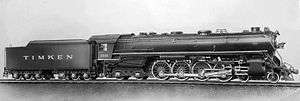Timken 1111
Timken 1111, also called the Timken Four Aces, was a 4-8-4 steam locomotive built in 1930 by American Locomotive Company (Alco) to serve as a demonstration unit for new roller bearings produced by the Timken Roller Bearing Company. It was the first locomotive built with all sealed roller bearings rather than the plain bearings or a mix of the two types.
| Timken 1111 | |||||||||||||||||||||||||||||||||||
|---|---|---|---|---|---|---|---|---|---|---|---|---|---|---|---|---|---|---|---|---|---|---|---|---|---|---|---|---|---|---|---|---|---|---|---|
 Timken 1111 as built. | |||||||||||||||||||||||||||||||||||
| |||||||||||||||||||||||||||||||||||
| |||||||||||||||||||||||||||||||||||
| |||||||||||||||||||||||||||||||||||
| |||||||||||||||||||||||||||||||||||
Design and construction
Timken chose a 4-8-4 on which to demonstrate the company's bearings so the locomotive could be used in all types of railroad work, especially on heavy freight and fast passenger trains. A total of 52 different parts manufacturers agreed to supply their parts for the locomotive "on account" until the locomotive operated over 100,000 miles (161,000 km). The suppliers' names were placed on a plaque that was fastened to the tender for the duration of the demonstration period.
Assembly took place at Alco's Schenectady, New York, plant, the former Schenectady Locomotive Works.
In-service demonstration
The locomotive's first demonstration runs were hauling freight on the New York Central Railroad. After those demonstrations, it was used on thirteen other major railroads, including the Chesapeake and Ohio Railroad, New Haven Railroad and Pennsylvania Railroad (PRR), in both freight and passenger service. The PRR used the locomotive on a passenger train where it hauled twelve passenger cars through the Allegheny Mountains so well that the train did not require the use of helpers and arrived at its destination three minutes early.
At some of the stations on the locomotive's demonstration runs, publicity stunts were held where the locomotive would be pulled by as few as three men (or as was done in Chicago, by three women); these publicity stunts were designed to show that the roller bearings produced so little friction that the locomotive could easily be moved by hand.
By August 1931, the locomotive had been used for over 90,000 miles (145,000 km) when it was delivered to the Northern Pacific Railroad, the fifteenth railroad to demonstrate the locomotive. With a dynamometer car in tow, the Northern Pacific was able to drive the locomotive at sustained speeds as high as 88 mph (142 km/h) while pulling the North Coast Limited passenger train past Willow Creek, Montana. However, while in service for the Northern Pacific 1111 suffered severe crown sheet damage. Timken demanded that Northern Pacific repair it, while Northern Pacific refused to repair a locomotive they did not own. The resulting agreement led to the sale of 1111 to Northern Pacific.
Regular use and disposition
The Northern Pacific purchased the 1111 from Timken on February 8, 1933, after it crossed the 100,000-mile (160,000 km) mark. The railroad renumbered it to 2626, classifying it internally as locomotive class A-1 (this locomotive was the class's sole member), and used it in passenger service between Seattle and Yakima, Washington, and later shifted its service to passenger trains between Seattle and Missoula, Montana. Northern Pacific used the locomotive for 23 years before retiring it from active service. The locomotive's last run was made on August 4, 1957 when it pulled a passenger train from Seattle to Cle Elum and return.
Efforts were made at preservation for the locomotive, and the Timken Company even seriously attempted to purchase the locomotive and move it back to the company's Canton, Ohio, headquarters under its own power. But the locomotive was scrapped before Timken and Northern Pacific could complete their negotiations.
References
- 1930 Timken Roller Bearing Company Engine. Retrieved October 17, 2005.
- Nixon, Ron; Northern Pacific Locomotives: Class A-1 (2626) 4-8-4 Northern. Retrieved October 17, 2005.
- The Timken Company, The History of Timken Rail Bearings. Retrieved October 17, 2005.
External links
- Ron Nixon's Northern Pacific Photos. Northern Pacific 2626, a 4-8-4 Northern Class A-1, is ready for an exhibition train at Missoula, Montana.
- SteamLocomotive.com - Northern Pacific Northerns. Further discussion of 4-8-4 use on the Northern Pacific.